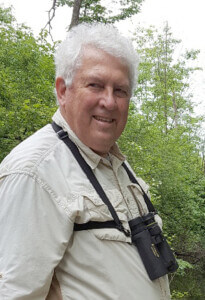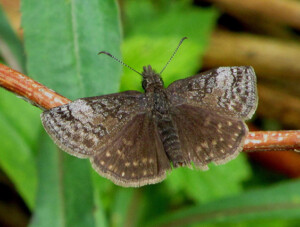Records Check Finds 66 Butterfly Species
By Ranger Steve Mueller
 Fifty-three field notebooks and journals hold my field study natural history data. Until 2010 I recorded observations with paper with pencil. I made the switch to entering information to a Word document on computer in November 2009.
Fifty-three field notebooks and journals hold my field study natural history data. Until 2010 I recorded observations with paper with pencil. I made the switch to entering information to a Word document on computer in November 2009.
Slowly I am transcribing older handwritten entries to computer documents. The process allows me to relive past field and family events and it will be easy to pass them on to family members. If desired each great great great great grandchild can have a digital copy from this ancient naturalist that they will never meet. Excel files contain records of collected insects, mounted birds, and daily sighting observations that include dates for flowering plants, when frogs began calling in spring, and other vital data.
Perhaps the data is only vital to me but I hope it is retained and used well beyond my existence. Recently, I found observation records for Ody Brook Nature Sanctuary that were not listed on the sanctuary’s checklists. The butterfly checklist had 62 species listed but four additional species were discovered during a records check.

Dreamy Duskywing (pictured at right), Dainty Sulphur, Leonard’s Skipper, and Indian Skipper were observed or collected but had not been added to the checklist. The updated checklist now has 66 species. Perhaps I will find more as I continue the records check while digitizing my journals.
It is surprising that I have seen 66 butterfly species at Ody Brook’s 61-acre sanctuary. That is 42% of all documented Michigan butterflies. Scientific proof requires a specimen to provide physical evidence or at a minimum a picture that shows identification characteristics. Eleven species seen have not been collected.
I should collect each species for deposition in the Michigan State University museum collection where voucher specimens document occurrence. Some species look so similar they cannot be separated with photographs. For 150 years we thought the Pearl Crescent and Northern Crescent were one species until further study revealed they were different species. The Spring Azure has been found to be a complex of different species.
Recorded information does not help when one species is found to be two species. The actual specimen needs to be examined. In some cases species can be identified based on field notes or pictures.
Ody Brook’s mission of “Biodiversity Enhancement” has made it possible to maintain varied habitats and find 66 butterfly species. I wonder if any nature sanctuary, nature center, or conservancy preserve, county, state, or national park in Michigan has as many species documented.
“All taxa biodiversity surveys” help document species for selected study areas. I have participated in some where I focused on butterflies but also assisted other scientists with other taxa inventory. Worldwide data bases where people record their observations helps. One of the largest and best known is ebird. Specialized websites exist for species groups that might interest you. Perhaps flowers, dragonflies, grasshoppers, mammals, frogs, or fish might serve your interests.
Opportunities are available for your focus at a land conservancy preserve, park, nature center or your yard. The world of nature study inventory is engaging, mind strengthening, and open to your personal interest. There are always new nature niche discoveries to be explored.
Natural history questions or topic suggestions can be directed to Ranger Steve (Mueller) at [email protected] – Ody Brook Nature Sanctuary, 13010 Northland Dr. Cedar Springs, MI 49319 or call 616-696-1753.
